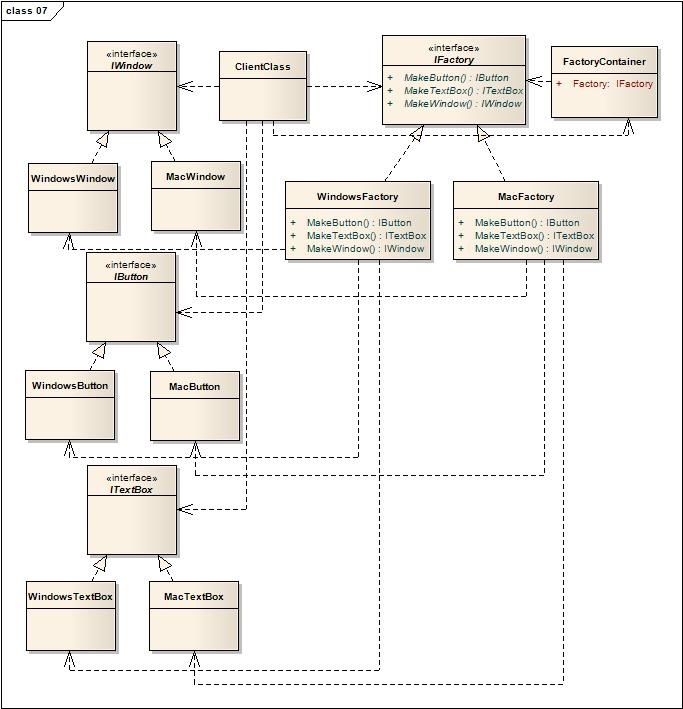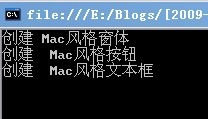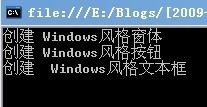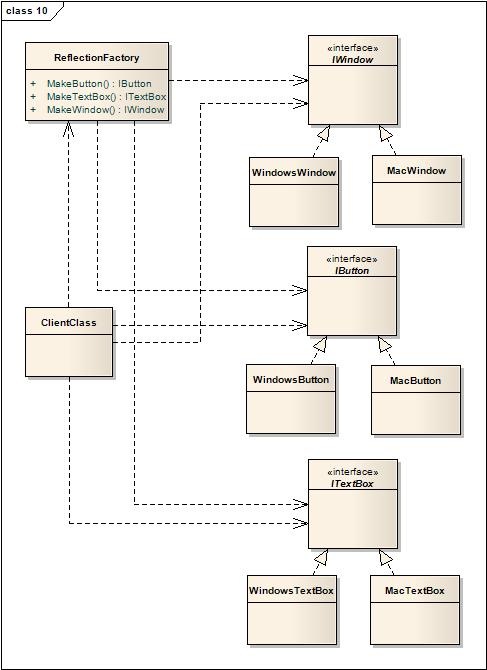【推荐】2019 Java 开发者跳槽指南.pdf(吐血整理) >>> 
一、什么是依赖注入
依赖注入的正式定义:
依赖注入(Dependency Injection),是这样一个过程:由于某客户类只依赖于服务类的一个接口,而不依赖于具体服务类,所以客户类只定义一个注入点。在程序运行过程中,客户类不直接实例化具体服务类实例,而是客户类的运行上下文环境或专门组件负责实例化服务类,然后将其注入到客户类中,保证客户类的正常运行。
二、依赖注入的类别
1.Setter注入
Setter注入(Setter Injection)是指在客户类中,设置一个服务类接口类型的数据成员,并设置一个Set方法作为注入点,这个Set方法接受一个具体的服务类实例为参数,并将它赋给服务类接口类型的数据成员。
下面给出Setter注入的示例代码。
using System;
using System.Collections.Generic;
using System.Linq;
using System.Text;
namespace SetterInjection
{
internal interface IServiceClass
{
String ServiceInfo();
}
}
using System;
using System.Collections.Generic;
using System.Linq;
using System.Text;
namespace SetterInjection
{
internal class ServiceClassA : IServiceClass
{
public String ServiceInfo()
{
return "我是ServceClassA";
}
}
}
using System;
using System.Collections.Generic;
using System.Linq;
using System.Text;
namespace SetterInjection
{
internal class ServiceClassB : IServiceClass
{
public String ServiceInfo()
{
return "我是ServceClassB";
}
}
}
using System;
using System.Collections.Generic;
using System.Linq;
using System.Text;
namespace SetterInjection
{
internal class ClientClass
{
//注入点
private IServiceClass _serviceImpl;
//客户类中的方法,初始化注入点
public void Set_ServiceImpl(IServiceClass serviceImpl)
{
this._serviceImpl = serviceImpl;
}
public void ShowInfo()
{
Console.WriteLine(_serviceImpl.ServiceInfo());
}
}
}
using System;
using System.Collections.Generic;
using System.Linq;
using System.Text;
namespace SetterInjection
{
class Program
{
static void Main(string[] args)
{
IServiceClass serviceA = new ServiceClassA();
IServiceClass serviceB = new ServiceClassB();
ClientClass client = new ClientClass();
client.Set_ServiceImpl(serviceA);
client.ShowInfo();//结果:我是ServceClassA
client.Set_ServiceImpl(serviceB);
client.ShowInfo();//结果:我是ServceClassB
Console.ReadLine();
}
}
}
运行结果如下:
2.构造注入
另外一种依赖注入方式,是通过客户类的构造函数,向客户类注入服务类实例。
构造注入(Constructor Injection)是指在客户类中,设置一个服务类接口类型的数据成员,并以构造函数为注入点,这个构造函数接受一个具体的服务类实例为参数,并将它赋给服务类接口类型的数据成员。
与Setter注入很类似,只是注入点由Setter方法变成了构造方法。这里要注意,由于构造注入只能在实例化客户类时注入一次,所以一点注入,程序运行期间是没法改变一个客户类对象内的服务类实例的。
由于构造注入和Setter注入的IServiceClass,ServiceClassA和ServiceClassB是一样的,所以这里给出另外ClientClass类的示例代码。
using System;
using System.Collections.Generic;
using System.Linq;
using System.Text;
namespace ConstructorInjection
{
internal class ClientClass
{
private IServiceClass _serviceImpl;
public ClientClass(IServiceClass serviceImpl)
{
this._serviceImpl = serviceImpl;
}
public void ShowInfo()
{
Console.WriteLine(_serviceImpl.ServiceInfo());
}
}
}
可以看到,唯一的变化就是构造函数取代了Set_ServiceImpl方法,成为了注入点。
3. 依赖获取
上面提到的注入方式,都是客户类被动接受所依赖的服务类,这也符合“注入”这个词。不过还有一种方法,可以和依赖注入达到相同的目的,就是依赖获取。
依赖获取(Dependency Locate)是指在系统中提供一个获取点,客户类仍然依赖服务类的接口。当客户类需要服务类时,从获取点主动取得指定的服务类,具体的服务类类型由获取点的配置决定。
可以看到,这种方法变被动为主动,使得客户类在需要时主动获取服务类,而将多态性的实现封装到获取点里面。获取点可以有很多种实现,也许最容易想到的就是建立一个Simple Factory作为获取点,客户类传入一个指定字符串,以获取相应服务类实例。如果所依赖的服务类是一系列类,那么依赖获取一般利用Abstract Factory模式构建获取点,然后,将服务类多态性转移到工厂的多态性上,而工厂的类型依赖一个外部配置,如XML文件。
不过,不论使用Simple Factory还是Abstract Factory,都避免不了判断服务类类型或工厂类型,这样系统中总要有一个地方存在不符合OCP的if…else或switch…case结构,这种缺陷是Simple Factory和Abstract Factory以及依赖获取本身无法消除的,而在某些支持反射的语言中(如C#),通过将反射机制的引入彻底解决了这个问题(后面讨论)。
下面给一个具体的例子,现在我们假设有个程序,既可以使用Windows风格外观,又可以使用Mac风格外观,而内部业务是一样的。
上图乍看有点复杂,不过如果读者熟悉Abstract Factory模式,应该能很容易看懂,这就是Abstract Factory在实际中的一个应用。这里的Factory Container作为获取点,是一个静态类,它的“Type构造函数”依据外部的XML配置文件,决定实例化哪个工厂。下面还是来看示例代码。由于不同组件的代码是相似的,这里只给出Button组件的示例代码,完整代码请参考文末附上的完整源程序。
using System;
using System.Collections.Generic;
using System.Linq;
using System.Text;
namespace DependencyLocate
{
internal interface IButton
{
String ShowInfo();
}
}
using System;
using System.Collections.Generic;
using System.Linq;
using System.Text;
namespace DependencyLocate
{
internal sealed class WindowsButton : IButton
{
public String Description { get; private set; }
public WindowsButton()
{
this.Description = "Windows风格按钮";
}
public String ShowInfo()
{
return this.Description;
}
}
}
using System;
using System.Collections.Generic;
using System.Linq;
using System.Text;
namespace DependencyLocate
{
internal sealed class MacButton : IButton
{
public String Description { get; private set; }
public MacButton()
{
this.Description = " Mac风格按钮";
}
public String ShowInfo()
{
return this.Description;
}
}
}
using System;
using System.Collections.Generic;
using System.Linq;
using System.Text;
namespace DependencyLocate
{
internal interface IFactory
{
IWindow MakeWindow();
IButton MakeButton();
ITextBox MakeTextBox();
}
}
using System;
using System.Collections.Generic;
using System.Linq;
using System.Text;
namespace DependencyLocate
{
internal sealed class WindowsFactory : IFactory
{
public IWindow MakeWindow()
{
return new WindowsWindow();
}
public IButton MakeButton()
{
return new WindowsButton();
}
public ITextBox MakeTextBox()
{
return new WindowsTextBox();
}
}
}
using System;
using System.Collections.Generic;
using System.Linq;
using System.Text;
namespace DependencyLocate
{
internal sealed class MacFactory : IFactory
{
public IWindow MakeWindow()
{
return new MacWindow();
}
public IButton MakeButton()
{
return new MacButton();
}
public ITextBox MakeTextBox()
{
return new MacTextBox();
}
}
}
using System;
using System.Collections.Generic;
using System.Linq;
using System.Text;
using System.Xml;
namespace DependencyLocate
{
internal static class FactoryContainer
{
public static IFactory factory { get; private set; }
static FactoryContainer()
{
XmlDocument xmlDoc = new XmlDocument();
xmlDoc.Load("http://www.cnblogs.com/Config.xml");
XmlNode xmlNode = xmlDoc.ChildNodes[1].ChildNodes[0].ChildNodes[0];
if ("Windows" == xmlNode.Value)
{
factory = new WindowsFactory();
}
else if ("Mac" == xmlNode.Value)
{
factory = new MacFactory();
}
else
{
throw new Exception("Factory Init Error");
}
}
}
}
using System;
using System.Collections.Generic;
using System.Linq;
using System.Text;
namespace DependencyLocate
{
class Program
{
static void Main(string[] args)
{
IFactory factory = FactoryContainer.factory;
IWindow window = factory.MakeWindow();
Console.WriteLine("创建 " + window.ShowInfo());
IButton button = factory.MakeButton();
Console.WriteLine("创建 " + button.ShowInfo());
ITextBox textBox = factory.MakeTextBox();
Console.WriteLine("创建 " + textBox.ShowInfo());
Console.ReadLine();
}
}
}
这里我们用XML作为配置文件。配置文件Config.xml如下:
<?xml version="1.0" encoding="utf-8" ?>
<config>
<factory>Mac</factory>
</config>
可以看到,这里我们将配置设置为Mac风格,编译运行上述代码,运行结果如下:
配置Mac风格后的运行结果
现在,我们不动程序,仅仅将配置文件中的“Mac”改为Windows,运行后结果如下:
配置为Windows风格后的运行结果
从运行结果看出,我们仅仅通过修改配置文件,就改变了整个程序的行为(我们甚至没有重新编译程序),这就是多态性的威力,也是依赖注入效果。
反射与依赖注入
回想上面Dependency Locate的例子,我们虽然使用了多态性和Abstract Factory,但对OCP贯彻的不够彻底。在理解这点前,朋友们一定要注意潜在扩展在哪里,潜在会出现扩展的地方是“新的组件系列”而不是“组件种类”,也就是说,这里我们假设组件就三种,不会增加新的组件,但可能出现新的外观系列,如需要加一套Ubuntu风格的组件,我们可以新增UbuntuWindow、UbuntuButton、UbuntuTextBox和UbuntuFactory,并分别实现相应接口,这是符合OCP的,因为这是扩展。但我们除了修改配置文件,还要无可避免的修改FactoryContainer,需要加一个分支条件,这个地方破坏了OCP。依赖注入本身是没有能力解决这个问题的,但如果语言支持反射机制(Reflection),则这个问题就迎刃而解。
我们想想,现在的难点是出在这里:对象最终还是要通过“new”来实例化,而“new”只能实例化当前已有的类,如果未来有新类添加进来,必须修改代码。如果,我们能有一种方法,不是通过“new”,而是通过类的名字来实例化对象,那么我们只要将类的名字作为配置项,就可以实现在不修改代码的情况下,加载未来才出现的类。所以,反射给了语言“预见未来”的能力,使得多态性和依赖注入的威力大增。
下面是引入反射机制后,对上面例子的改进:
可以看出,引入反射机制后,结构简单了很多,一个反射工厂代替了以前的一堆工厂,Factory Container也不需要了。而且以后有新组件系列加入时,反射工厂是不用改变的,只需改变配置文件就可以完成。下面给出反射工厂和配置文件的代码。
using System;
using System.Collections.Generic;
using System.Linq;
using System.Text;
using System.Reflection;
using System.Xml;
namespace DependencyLocate
{
internal static class ReflectionFactory
{
private static String _windowType;
private static String _buttonType;
private static String _textBoxType;
static ReflectionFactory()
{
XmlDocument xmlDoc = new XmlDocument();
xmlDoc.Load("http://www.cnblogs.com/Config.xml");
XmlNode xmlNode = xmlDoc.ChildNodes[1].ChildNodes[0];
_windowType = xmlNode.ChildNodes[0].Value;
_buttonType = xmlNode.ChildNodes[1].Value;
_textBoxType = xmlNode.ChildNodes[2].Value;
}
public static IWindow MakeWindow()
{
return Assembly.Load("DependencyLocate").CreateInstance("DependencyLocate." + _windowType) as IWindow;
}
public static IButton MakeButton()
{
return Assembly.Load("DependencyLocate").CreateInstance("DependencyLocate." + _buttonType) as IButton;
}
public static ITextBox MakeTextBox()
{
return Assembly.Load("DependencyLocate").CreateInstance("DependencyLocate." + _textBoxType) as ITextBox;
}
}
}
配置文件如下:
<?xml version="1.0" encoding="utf-8" ?>
<config>
<window>MacWindow</window>
<button>MacButton</button>
<textBox>MacTextBox</textBox>
</config>
反射不仅可以与Dependency Locate结合,也可以与Setter Injection与Construtor Injection结合。反射机制的引入,降低了依赖注入结构的复杂度,使得依赖注入彻底符合OCP,并为通用依赖注入框架(如Spring.NET中的IoC部分、Unity等)的设计提供了可能性。
来源:oschina
链接:https://my.oschina.net/u/3097161/blog/3154294




